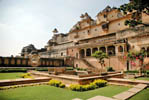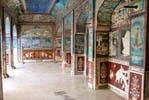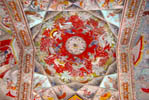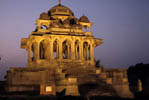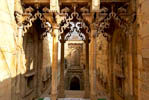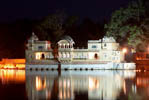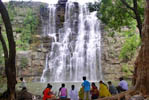|
Bundi just 36 km from Kota is a tiny picturesque town. One of the unexplored cities with a rich historical wealth. Once a part of Kota, it was ruled by the Had Chauhans - a offshoots of the famous
Chauhan clan who ruled Delhi and Ajmer. In 1193 AD when Prithvi Raj Chauhan was defeated by Sultan Mohammed Gauri, some Chauhan nobles seeked shelter in Mewar and became allied to the Rana while other
young warriors moved towards the Chambal valley and overpowered the Meena and Bhil tribals - thus establishing their own kingdom of Hadoti. Later, two branches of Hadas formed tow separate states of
Kota and Bundi, on either side of the River Chambal. Bundi is surrounded by the Aravalli hills on the three sides and is circumscribed by a massive wall with four gateways. Interesting monuments including
impressive medieval forts, palaces, havelis, temples with beautiful stone idols and chattris with carved pillars, along with a picturesque lake in the heart of the town, add to its charm. Bundi is very
famous for its intricate carvings and murals.
TOP
PLACES OF INTEREST ARE:
Taragarh Fort: The serpentine Taragarh Fort and its palace is what immediately strike visitors on arrival in Bundi. Rudyard Kipling who visited here a century ago wrote, "No human hand can
create such a splendour; for only angels have that skill". Taragarh is Bundi's pride. This imposing fort was raised at a height of 500 meters atop a hill by Rao Bar Singh in the 13th century.
Strong bastions the biggest being Bhim Burj, rise above the chain of palaces built by different rulers over a period of time. A huge reservoir within the fort provided the place white water. A curious
feature about it is that whenever the water lever rises above the danger level, sluice gates are opened and the running water makes the lanes of the city turn into miniature canals. Striking features of
the fort are the Chhatra Mahal, Badal Mahal and Ratan Daulat - Diwan-I-Aam, built by Rao Raja Ratan Singh (1607-31). The Chhatra Mahal was founded by Raja Chhatrasal in 1660 the famous Bundi Kalam
miniatures can be found here. The Zenana Mahal and the Badal Mahal also have an excellent collection of miniatures. The famous Chitrashala, built by Rao Raja Umed Singh (1739-70) has open galleries
running around it and have the best of Bundi wall painting depicting the Raas Leela, court life and beautiful women. To view the other frescoe-covered palaces, permission is required form the royal
family as the fort is private property. The Chhatra Mahal, Phool Mahal and Badal Mahal and Bundi miniatures have been recognized, world wide, for their superb quality.
The Palace: This magnificent edifice is a fine example of the Rajput architecture, housing some of the superb Bundi murals.
Chhattar Mahal: A steep, paved carriage-way is the only way to reach the monument. Of special interest in the palace is the Hazari Pol or Gate of the thousand, the Naubat Khana, the Hathi
Pol with its old water clock and the Diwaan-e-Aam.
Ratan Daulat: Built by Rao Raja Ratan Singh, it is a very interesting structure forming a stable for nine horses and a Hatia Pol. (Prior permission required fro visit.)
Chitrashala: A fascinating pavilion and a gallery of miniature murals embellish the palace. Elaborate colourful paintings on the walls depicts scenes from the 'Ragmala' and Raasleela' - the
Radha-Krishna story.
Nawal Sagar: Visible from the fort is the square artificial lake of Nawal Safar, broken up by islets. A temple dedicated to Varuna, the Aryan got of water, stands half submerged in the
centre of the lake. The reflection of the entire city and its palaces can be seen in the lake-making it a unique attraction of Bundi.
Step-wells of Bundi: For anyone who wants to see the beauty of different types of stepwells, a visit to the township of Bundi is recommended. A number of stepwells have been made over a period
of three centuries by members of the royal families as well as the people of Bundi who took interest in a worthwhile cause. Out of around 20 stepwells in the area, those worth a mention are Naval
Sagar, Sisodiaji ki Baori, Purushottam ki Baori, Sukhi Baori, Manoharji ki Baori and RAmi ki Baori.
While baoris in Rajasthan display a dexterity and architectural beauty typical of the state, non them compare with Rani ka Vav (queen's stepwell) at Patan, Gujarat, except the Rani ki Baori at
Bundi. Though not as large in its dimensions, it is extremely ornate and embellished with excellent of carving of elephants with their trunks turned inwards, as if they had taken water of the
baori and were quenching their thirst. As you descend towards the water source, large well preserved statures of Ganesh, Saraswati and the ten incarnations like Matsya, Varaha and Narsingh attract
your attention thou some of them have become victims of the elements over time. The well has depth of 46 metres and a very ornate & exquisitely carved Toran Dwar. The length and breadth of
the baori is 40'*30'. The delicately chiseled arches on the columns add to the beauty and grandeur of the total structure which is an example of the Rajasthani baori architecture at its best. This baori
was built in 1600 AD by Rani Natawati, wife of Rao Raja Anirudh Singh. She is reported to have commissioned nearly 21 baoris.
Another stepwell is Dhabaiji ka Kund which was constructed by Dhabaiji Raj of Bundi in 1911 AD. It is situated near the Lanka Gate. The stairs lead down to a depth of around 50 feet. There are
two rooms with windows (Jharokha).
Sukh Mahal: A magnificent summer palace on the Sukh Sagar Lake amid the luch surroundings of a beautiful garden. An underground tunnel is believed to run from the Sukh Mahal to the old Palace.
Phool Sagar: The 20th century palace with an artificial tank and picturesque gardens. Presently, it is the residence of the former ruler. (Prior permission of secretary is required for a visit.)
Shikhar Burj: Located in the sun-dappled forest, Shikhar Burj was the royal hunting lodge. Wild-life in the Bundi woods comprised tigers, deer and boar. The royal hunts of Bundi were well renowned.
Keshar Bagh: An ancient garden near the Shikhar Burj with beautiful chhatirs of the Bundi rulers and their queens all examples of the town's rich architecture. (Prior permission
required for visit.) Eighty four pillared cenotaph: an amazingly magnificient memorial with 84 pillars in a single cenotaph along with a Shiva Lingam. It was erected by Rao Anirudh.
TOP
EXCURSIONS:
Jait Sagar Lake (3 km): A picturesque lake cradled in the hills, built by Jaita Meena. The swirling fountain at night is a visual delight.
Rameshwaram: The cave temple Lord Shiva surrounded by the Aravalli ranges. An ideal picnic spot as well.
Keshoraipatan: Perched majestically on the bank of the river Chambal, the temple of Keshoraipatan is nestled in an idyllic location. Although it is located in the Bundi district, it is just 9 kms.
away from Kota.
Keshoraipatan was called "Patan" in the ancient times and it was ruled by King Ranti Dev. Keshoraipatan is one of the oldest cities whose past can be traced to ancient times when it was a religious
center. The city witnessed many ups and downs and its archaeological remains reflect its past glory.
Keshoraipatan is famous for its temple known by the same name. It was renovated by Rao Raja Chhatrasal (1631-1658) of Bundi. The temple stands, beautifully on the plains against the backdrop[ of
clear blue sky, amid a sylvan setting with the river Chambal flowing silently nearby. It is so perfect in its design and construction that the temple remains safe even during the monsoons, when the
Chambal is in spate. Keshoraipatan becomes "mini-pushkar" on the night of the full moon in the month of Kartika. Early in the morning, the banks of river Chambal witness a colourful scene of
Men & Women, clad in fantastic costumes mirrored in the crystal clear water of the river Chambal. Women float lighted diyas (lamps prepared by them from flour dough), into the river and seek boons.
The temple and the scenic beauty arrest the attention of visitors and speak of its grandeur and glory in silence.
Indergarh: Founded by Raja Indrasal of the royal house of Bundi in 1605, Indergarh (80 km), though a small little town has a beautiful fort which contains some excellent frescoes. It is also
famous for the Bijasan Mata Temple & Kamleswar Mahadeo at Kuwalji.
Menal-Bijolia Temple Complexes: A road through rocky terrain, south of Bundi, takes you on to Bijolia (54 km) and Menal (70 km), temple towns of the 12th century. Menal was once the
mountain retreat of Prithvi Raj Chauhan of Delhi. A few decaying palaces still exist here. But it is the temples which catch your eye, with the impressive Nandi Bull, the Shiv and Parvati statures
(still in excellent condition) and a domed pavilion on the terrace which affords excellent views. The Menal River, falling into various gorges from its splendid heights, is a fantastic sight.
Ramgarh Sanctuary (45 km): The Ramgarh Sanctuary is located on the Nainwa road. One need to take permission of the State Forest Department prior to a visit to the sanctuary.
Talwas (53 km): A magnificent fort built by the ruler Ajit Singh. A temple of Dhooleshwar Mahadev and a picturesque waterfall adjoining the fort are worth a visit. The beautiful Ratna Sagar
Lake is close by and is a haven for fauna like bear and deer during the monsoon.
Dugari (65 km): Remnants of ancient wall paintings can be seen in the Ram Mandir within the imposing fort of Dugari.
FAIRS & FESTIVALS:
Kajli Teej: Teej Festival is celebrated all over the state with each region having its own unique touch. Kajli Teej of Bundi is different in several ways - while Teej is celebrated on the
third day of the Shravan Month, in Bundi it is celebrated on the third day of the Bhadra Month. The festival starts with the procession of goddess Teej in a decorated palanquin from the beautiful Naval
Sagar. It passes through the main bazaars and terminates at Azad Park. The procession has decorated elephants, camels, bands, performing artists and colourfully dressed people.
The people who gather here from surrounding areas also get to watch and participate in the cultural programmes that are organized in the evenings. It provides a very good chance to see performances by
local artists from Hadoti region.
Though the main function of Teej is held only on two days, the celebrations continue upto Janmashtami, which marks the birth of Lord Krishna. |







